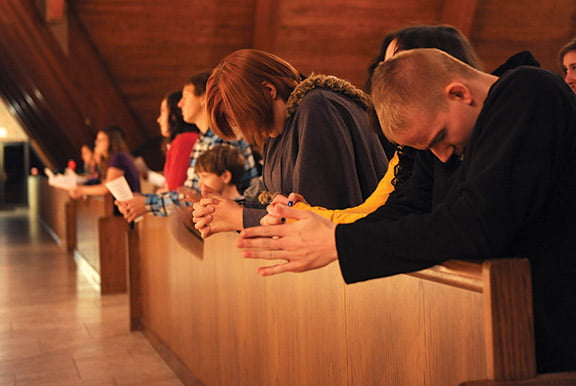
More than 2,000 years later, Catholics still use the prayer Jesus taught his disciples — a prayer that was revolutionary at the time.
by Woodeene Koenig-Bricker
Special to The Leaven
St. Thérèse of Lisieux said, “For me, prayer is a surge of the heart; it is a simple look turned toward heaven, it is a cry of recognition and of love, embracing both trial and joy.”
Nice for Thérèse, but for us non-saints, prayer can be a bit more difficult. We can recite words, but we don’t always feel like our prayers are effective.
Like one of Jesus’ disciples, we want to say, “’Lord, teach us to pray” (Lk 11:1).
It’s not that the disciples really didn’t have a clue as to how to pray. Ritually repeated words to a deity have been a part of human experience since the creation. Many of the earliest known writings from the ancient world are prayers.
We have well-documented texts from Babylonia, the Hittite Empire and ancient Egypt, to name only a few. The Old Testament is replete with prayers of the patriarchs, the prophets, and the people themselves.
So why did the disciples want Jesus to teach them how to pray when they lived in a prayer-saturated culture?
The answer has to do with the Holy Spirit.
Before Jesus, the Holy Spirit came upon only select individuals to empower them for a task or role.
For example, “the spirit of the Lord came upon Gideon, and he blew a trumpet” (Jgs 6:34).
However, the Spirit didn’t always remain with a person for life. When the task was completed or if the person sinned, the Spirit would depart. That’s what happened when King Saul refused to obey one of God’s orders: “the spirit of the Lord departed from Saul” (1 Sm 16:14).
This selective coming and going of the Spirit changed at Pentecost when the Spirit descended like wind and fire and filled all who were present in the Upper Room. No longer was the Spirit’s presence limited to certain people assigned to complete certain tasks.
But from now on, the Spirit could dwell in all who were baptized in the name of the Trinity. Peter says as much when he quotes from the prophet Joel saying, “‘It will come to pass in the last days,’ God says, ‘that I will pour out a portion of my spirit upon all flesh’” (Acts 2:17).
So what’s the relationship of the Spirit to prayer?
When the Holy Spirit is with a person, God himself enters into the most intimate relationship possible with that person. Since prayer, like St. Thérèse said, is ultimately a “surge of the heart,” when we become temples of the Spirit, our hearts are united with God and our prayers become a true communion with the Trinity.
We no longer have to find the exact right words to address God, but the Spirit actually prays for us: “In the same way, the Spirit too comes to the aid of our weakness; for we do not know how to pray as we ought, but the Spirit personally intercedes with inexpressible groanings” (Rm 8:26).
From the beginning of time, we have sought to encounter and engage the Divine, but it is only after Jesus asked the Father to send the Holy Spirit — “another Paraclete to be with you forever” (Jn 14:16) — that we truly have been able to pray with confidence that our “cry of recognition and of love” will always be heard and answered.
The result of union with the Spirit is that God is not a far-removed deity who demands sacrifice. Instead God, in the words of Jesus, becomes our Father.
When the disciples heard Jesus address God in such close, intimate terms as “Abba” (which can translate almost to “Daddy”), they were undoubtedly surprised. But they had also seen how Jesus’ prayers were answered in literally miraculous fashion, resulting in healings of the sick and even raising of the dead.
It’s little wonder that they wanted to know how to pray with the same kind of efficacy that Jesus prayed.
In response to their request, Jesus taught them the Our Father. Although they would not be able to experience full union with the
Father until after Pentecost, Jesus gave them — and us — the model for all future discourse.
Because we say the Lord’s Prayer so often, we can fail to appreciate how revolutionary it really is.
First, it calls God “Father,” but more than that, it reminds us that God isn’t just “my” father, but “our” father. We are family.
Then the prayer goes on to show us that adoration (“hallowed be thy name”) should come before anything else. It’s only after we acknowledge God’s loving sovereignty that we begin our supplication.
Even then, Jesus points out that while we should ask for our needs (“daily bread”), the most important need is to both forgive and be forgiven.
Finally, we are reminded of our frailty (“lead us not into temptation”) and our dependence on our “Daddy” to “deliver us from evil.”
In these simple words that Jesus gave to his disciples, the way humanity prays was changed forever.






